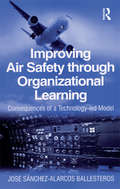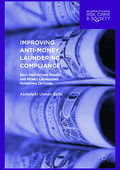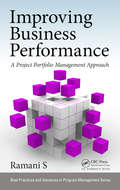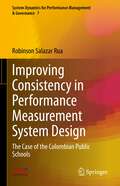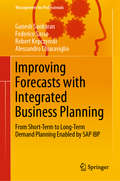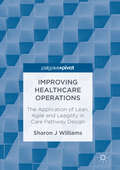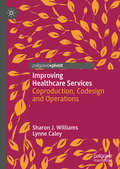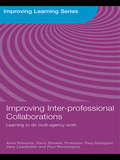- Table View
- List View
Improving Air Safety through Organizational Learning: Consequences of a Technology-led Model
by Jose Sanchez-Alarcos BallesterosThe key theme of this book is organizational learning and its consequences for the field of aviation safety. Air safety rates have been improving for a long time, demonstrating the effects of a good learning model at work. However, the pace of improvement has almost come to a standstill. Why is this? Many safety improvements have been embodied in technology. New devices and procedures appear almost daily, yet the rate of air safety improvement has dragged in recent years. Improving Air Safety through Organizational Learning explains this situation as being the consequence of a development model supported chiefly by information technology being introduced as an alternative to human operators. This is not a book about the convenience of including or not including IT in aviation, but an open discussion about the adequacy and risks of some practices in the field. Two different but complementary issues emerge. Firstly, a real improvement in air safety requires a different approach, since the present one seems now to be exhausted. Secondly, the current approach has powerful economic roots, and any new approach must deal with this fact, improving safety rates without becoming financially damaging. Consequently the book is divided into two parts. Part one deals with the issue of the present learning model organizing the conclusions around accident reports that show themselves the existence of a problem: the present use of technology makes the system better at doing things already known, while at the same time it makes the whole system worse at dealing with unplanned situations. Part two suggests a new development model, one that makes strong use of technology but at the same time questions every step: what knowledge will disappear from the system and what is the potential effect of that loss?
Improving Anti-Money Laundering Compliance
by Abdullahi Usman BelloThis book provides practical recommendations on how to improve the effectiveness and efficiency of AML compliance by introducing the theory, framework and approach for dealing with the concerns of Money Laundering Reporting Officers (MLROs) within the UK banking industry. Accordingly, Bello focusses on providing a theoretical explanation of compliance behaviour which is inadequately covered. Although the research is centred on MLROs within the UK banking industry, the self-protecting theory discovered from the research has general application to other compliance officers within and outside the UK. It is also applicable to regulatory environments in other economic sectors. The choice of MLROs and the UK as the focus of the study was because these individuals are arguably the most important stakeholders in AML and the UK is one of the largest financial centres in the world that provides opportunity for money laundering activities. A methodological and detailed study, this book will be of particular interest to practitioners and the regulatory authorities, as well as scholars of criminology and finance.
Improving Biogas Production: Technological Challenges, Alternative Sources, Future Developments (Biofuel and Biorefinery Technologies #9)
by Helen Treichel Gislaine FongaroThis book highlights the current limitations of biogas production and yield and new avenues to improving them. Biogas production and yield are among the most important renewable energy targets for our world. Pursuing an innovative and biotechnological approach, the book presents alternative sources for biogas production and explores a broad range of aspects, including: pre-treatment of substrates, accelerators (enzyme-mediated) and inhibitors involved in the process of obtaining biogas and its yield, design specifications for digesters/modified digesters, managing biogas plants, microbial risk and slurry management, energy balance and positive climatic impacts of the biogas production chain, and the impacts on Human, Animal and Environmental Health (“One Health” concept for the biogas chain).
Improving Business Performance: A Project Portfolio Management Approach (Best Practices in Portfolio, Program, and Project Management)
by Ramani SNo organization is impervious to change. Rather, the survival and growth of an organization is dependent on how well it copes with change. Successful change initiatives consist of the integrated eco-system of its portfolio, programs, and projects. These change initiatives become the delivery mechanisms for implementing the strategy of an organization.Improving Business Performance: A Project Portfolio Management Approach clarifies how the proper application of portfolio, program, and project management concepts can help commercial and non-profit organizations achieve their strategic objectives. Most organizations have been good at devising strategy, but falter during its implementation. Executing strategy well to deliver superior business performance remains a key challenge, which is addressed as the core theme of this book.The book portrays a top-down orientation as well as a bottom-up integration of change initiatives to facilitate alignment to strategy and accommodate mid-course changes. It takes into account existing global best management practices to bring forth an approach that is customizable and useful to organizations in any industry.Describing why portfolio management lies at the apex of change initiative management, the book explains how to design and fine-tune portfolios so they are in alignment with your organization’s overall strategy and business needs. After reading this book, you will understand: How to design the project portfolio structure for your organization How to integrate programs and projects within the portfolio more effectively How to better manage interactions across diverse change initiatives How to maintain focus while managing change to realize benefits The book presents a case study that illustrates the application of project portfolio concepts in practical scenarios. It includes chapters dedicated to transition management, change management, benefits management, and the Enterprise Project Management Office. It also includes templates you can immediately put to use in your own portfolios, programs, and projects.
Improving Business Process Performance: Gain Agility, Create Value, and Achieve Success
by Joseph RaynusThe managerial practices that successfully drove industry for decades have become insufficient to support the rapidly changing business landscape. Companies around the world are being challenged to improve performance, reshape operations, and adapt swiftly to new opportunities. With an abundance of improvement methodologies and frame
Improving Competitiveness through Human Resource Development in China: The Role of Vocational Education (Routledge Advances in Management and Business Studies)
by Ying Zhu Min MinThis book looks at the development of vocational education and training in China and how it is crucial to human resource development and improving competitiveness. It briefly outlines the contextual issues related to vocational education and training in China, the importance of vocational education and how China has been using vocational training to reduce the unemployment rate and raise its overall human capital.
Improving Consistency in Performance Measurement System Design: The Case of the Colombian Public Schools (System Dynamics for Performance Management & Governance #7)
by Robinson Salazar RuaThis book analyzes behavioral distortions in public schools and delineates outcome-based performance measurement systems that can prevent and mitigate them. An instrumental view of dynamic performance management (DPM) is used to support the endeavor by identifying how performance drivers affect end results of outcome and output, how end results affect strategic resources, and how strategic resources and benchmarks define the dynamics of performance drivers. This approach is also used to promote a shift from an output-oriented to an outcome-oriented view in performance management, with the aim of achieving sustainable results in the long term. The book also includes a comprehensive literature review at the end of each chapter, intended to strengthen readers’ knowledge and encourage further research. Given its scope, the book will appeal to graduate students in public management, researchers in performance management, system dynamics, and education, and decision-makers in public schools.
Improving Effective Coverage in Health: Do Financial Incentives Work? (Policy Research Reports)
by Friedman Adam Wagstaff Damien de Walque Eeshani Kandpal Moritz Piatti-Fünfkirchen Anja Sautmann Gil Shapira Ellen Van de PoelIn many low- and middle-income countries, health coverage has improved dramatically in the past two decades, but health outcomes have not. As such, effective coverage—a measure of service delivery that meets a minimum standard of quality—remains unacceptably low. Improving Effective Coverage in Health examines one specific policy approach to improving effective coverage: financial incentives in the form of performance-based financing (PBF), a package reform that typically includes performance pay to frontline health workers as well as facility autonomy, transparency, and community engagement. This Policy Research Report draws on a rich set of rigorous studies and new analysis. When compared with business-as-usual, in low-income settings with centralized health systems PBF can result in substantial gains in effective coverage. However, the relative benefits of PBF—the performance pay component in particular—are less clear when it is compared with two alternative approaches, direct facility financing, which provides operating budgets to frontline health services with facility autonomy on allocation, but not performance pay, and demand-side financial support for health services (that is, conditional cash transfers and vouchers). Although PBF often results in improvements on the margins, closing the substantial gaps in effective health coverage is not yet within reach for many countries. Nonetheless, important lessons and experiences from the rollout of PBF over the past decade can guide health financing into the future. In particular, to be successful, health financing reform may need to pivot from performance pay while retaining the elements of direct facility financing, autonomy, transparency, and community engagement.
Improving Employee Performance Through Appraisal and Coaching
by Donald L. KirkpatrickAuthor Donald Kirkpatrick is one of the leading voices on human resources and training and development. For more than forty years, Kirkpatrick’s four-level performance evaluation model has been the standard throughout the world, and has revolutionized the way enterprises manage, monitor, and optimize employee performance. The new edition of Improving Performance Through Appraisal and Coaching contains all the wisdom and step-by-step processes of the original, with all the guidance and tools you’ll need to implement a program that gets maximum results. The book starts with a 40-question test about your organization and its processes and attitudes regarding performance appraisal and coaching. Taking the test both before and after reading the first section of the book will highlight exactly where your existing initiatives can be improved and new ones put in place. Kirkpatrick then goes on to describe in detail how a culture of coaching builds and enhances performance, and how to build this culture across the entire organization. Examples and eye-opening Notes from the Field both reinforce and complement the author’s sage recommendations, illustrating how his approaches can be adopted in their entirety or deployed piecemeal, depending on your organization’s specific needs. The case studies, both from major employers, prove the overarching value of a proactive performance appraisal program and vibrant coaching environment. The book is packed with ready-to-use forms and, more important, instructions and observations on their effective use. Plus, every chapter is designed for practical application, featuring accessible charts and figures, lists of key points, specific suggestions, cause-and-effect relationships, and much more. While workplaces and jobs have changed dramatically, some truths seem everlasting. One is that in order to obtain exceptional employee performance, you need to build a thorough and consistent appraisal mechanism and coaching program. The other is that there is no one more knowledgeable about how to do it than Donald Kirkpatrick.
Improving Energy Efficiency in Commercial Buildings and Smart Communities: Proceedings of the 10th International Conference IEECB&SC’18 (Springer Proceedings in Energy)
by Paolo BertoldiThese proceedings present fourteen peer-reviewed papers from the 10th International Conference on Improving Energy Efficiency in Commercial Buildings and Smart Communities, which was held March 21-22, 2018 in Frankfurt, Germany. This biannual conference aims to promote and diffuse the concept of energy efficiency in new and existing commercial buildings and to enlarge the market for low consumption and sustainable non-residential buildings. It also covers smart and sustainable districts, communities and cities, since energy systems efficiency and renewable energies are often optimized at the district or municipal level. The 2018 conference focused on advanced and innovative technologies to improve the energy efficiency of commercial buildings, communities and cities as well as the policies and measures by governments at various levels to improve energy efficiency. A particular focus was on Energy Service Companies (ESCOs). The conference addresses energy policy makers at international, national, and local level; academics, researchers and energy efficiency experts; ESCOs, utilities, buildings energy and environmental managers; buildings engineers and architects; and equipment manufacturers and commercial property investors.
Improving Energy Efficiency in Industrial Energy Systems
by Jenny Palm Patrik ThollanderIndustrial energy efficiency is one of the most important means of reducing the threat of increased global warming. Research however states that despite the existence of numerous technical energy efficiency measures, its deployment is hindered by the existence of various barriers to energy efficiency. The complexity of increasing energy efficiency in manufacturing industry calls for an interdisciplinary approach to the issue. Improving energy efficiency in industrial energy systems applies an interdisciplinary perspective in examining energy efficiency in industrial energy systems, and discusses how "cross-pollinating" perspectives and theories from the social and engineering sciences can enhance our understanding of barriers, energy audits, energy management, policies, and programmes as they pertain to improved energy efficiency in industry. Apart from classical technical approaches from engineering sciences, Improving energy efficiency in industrial energy systems couples a sociotechnical perspective to increased energy efficiency in industry, showing that industrial energy efficiency can be expected to be shaped by social and commercial processes and built on knowledge, routines, institutions, and methods established in networks. The book can be read by researchers and policy-makers, as well as scholars and practicians in the field. "This book is extremely valuable for anyone who is designing or executing energy efficiency policies, schemes or projects aiming at SMEs. Both authors deserve the highest respect, and the combination of their expertise makes the results truly unique." - Daniel Lundqvist, programme manager at the Swedish energy agency "For anyone interested in improving energy efficiency in industry, this is a must-read. The book combines tools from social science and engineering to discuss the state of art today as well as possible development path tomorrow. This is a compelling book that I find useful both in my teaching and my research." - Kajsa Ellegård, Professor at Linköping University, Sweden "The book Improving energy efficiency in industrial energy systems is a novel approach on how improved levels of energy efficiency can be reached in industrial energy systems by merging engineering with social sciences. It is with delight that I can recommend their book to anyone interested in the field."- Mats Söderström, Director Energy Systems Programme, Linköping University, Sweden
Improving Food and Beverage Performance
by Keith WallerThe food and beverage aspect of hotel operations is often the most difficult area to control effectively, but it plays a crucial role in customer satisfaction. Improving Food and Beverage Performance is able to show how successful catering operations can increase profitability whilst providing continuing improvements in quality, value and service. Keith Waller looks at the practical issues of improving performance combining the key themes of quality customer service and efficient management. This text will enable managers and students alike to recognise all the contributing factors to a successful food and beverage operation.Keith Waller is Senior Lecturer for the Faculty of Business and Management at Blackpool and the Fylde College. He has extensive experience in the hospitality industry and is a member of the Hotel and Catering International Management Association. He is the co-author, with Professor John Fuller, of The Menu, Food and Profit.
Improving Forecasts with Integrated Business Planning: From Short-Term to Long-Term Demand Planning Enabled by SAP IBP (Management for Professionals)
by Robert Kepczynski Ganesh Sankaran Federico Sasso Alessandro ChiaraviglioThis book provides both a broad overview of the forecasting process, covering technological and human aspects alike, and deep insights into algorithms and platform functionalities in the IBP toolbox required to maximize forecast accuracy. Rich in technical and business explanations, it addresses short-, medium- and long-term forecasting processes using functionalities available in demand planning and demand sensing. There are also several theoretical concepts underpinning the algorithms discussed; these are explained with numerical examples to help demystify the IBP forecasting toolbox. Beyond standard procedures, the book also discusses custom approaches (e.g. new segmentation criteria, new outlier detection and correction methods) and new methods (e.g. the use of Markov chains for forecasting sporadic demands), etc. It subsequently benchmarks common practices using these innovative approaches and discusses the results. As measurement is an important precondition for improvement, an entire chapter is devoted to discussing process improvement and value using the Six Sigma methodology. In closing, the book provides several useful tips and tricks that should come in handy during project implementation.
Improving Global Environmental Governance: Best Practices for Architecture and Agency (Routledge Research in Global Environmental Governance)
by Steinar Andresen Peter M. Haas Norichika KanieThe experience of environmental governance is approached in Improving Global Environmental Governance from the unique perspective of actor configuration and embedded networks of actors, which are areas of emerging importance. The chapters look at existing Multilateral Environmental Agreements (MEAs) and the broader constellation of partially networked institutions to better understand the involvement of individual actors and how to deepen the networks that include them to generate more effective governance. The book covers a wide range of issued pertaining to environmental governance including trans-boundary air pollution, marine pollution, biodiversity and ozone depletion. It also examines partnerships as a hybrid case of emerging modes of environmental governance. These partnerships are a recent form of actor configuration that warrant attention for dealing with global environmental threats in order to better understand the full potential of actor configurations in the absence of state involvement. In order to test applicability to on-going but stalled processes, the book applies the approach to one of the most difficult issues we face: climate change. By addressing key questions in this important area, the book provides new perspectives in the nexus between agency and architecture in environmental governance in the twenty-first century.
Improving Governance and Fighting Corruption in the Baltic and CIS Countries: The Role of the IMF
by Thomas Wolf Emine GurgenA report from the International Monetary Fund.
Improving Healthcare Operations
by Sharon J WilliamsThis book examines the design of two care pathways to establish how key principles associated with systems thinking, quality improvement, and supply chain management can improve the design of these services. 'Lean' has typically been the prominent approach when improving the design of healthcare systems and is often selected by healthcare professionals to standardize and improve the delivery of care. Previous literature shows there has been varying success in the application of 'Lean', the author presents a study which examines the benefits of introducing 'Agile' as an alternative and complementary approach. Improving Healthcare Operations explores when 'Lean' and 'Agile' are most applicable, and instances where a hybrid approach can be employed. Including empirical qualitative data collected from two care pathways, it intends to provide organizations with an alternative in order to produce the level and quality of care that is expected by patients.
Improving Healthcare Services: Coproduction, Codesign and Operations
by Sharon J. Williams Lynne CaleyBuilding on co-author Sharon Williams’ previous title Improving Healthcare Operations, this book examines the role of co-design and coproduction in health and social care. Extending current thinking on coproduction in healthcare and how this can be operationalised, this book opens a discussion around how it can contribute to improvement. Providing a number of case studies, it links previous public service management, operations management and supply chain management research by extending and translating these core design and improvement principles into health and social care. Considering the wider role of patients, communities and other stakeholders it will challenge and develop existing thinking in relation to co-design, coproduction and redesign of services.
Improving Human Performance in Dynamic Tasks: Applications in Management and Industry (SpringerBriefs in Complexity)
by Hassan Qudrat-UllahThis book is about improving human decision making and performance in complex, dynamic tasks. The defining characteristics of a dynamic decision task are that there are a number of decisions required, that decisions are interdependent and that the environment in which the decision is made is transient and feedback is pervasive. Examples of dynamic tasks include the sustainable management of renewable resources and how businesses might allocate resources for research and development (R&D) projects. Decision making in dynamic tasks can be improved through training with system dynamics–based interactive learning environments (ILE’s) that include systematic debriefing. Some key features of the book include its didactic approach, numerous tables, figures, and the multidimensional evaluative model. Researchers can use the developed “evaluation model” to gauge various decision-aiding technologies. How to Improve Human Performance in Dynamic Tasks appeals to those interested in the design and evaluation of simulation-based decision support systems, as well as policy makers, students, researchers, and industrialists concerned by the issue of improving human performance in organizational tasks.
Improving Industrial Relations: The Advisory Role of ACAS (Routledge Library Editions: Industrial Relations)
by Rosemary Lucas Eric ArmstrongImproving Industrial Relations (1985) presents and discusses the findings of research into the advisory function of the Advisory, Conciliation and Arbitration Service (ACAS). ACAS is most widely known for its attempts to resolve industrial disputes through conciliation, but most of its endeavours lie in its advisory role to improving industrial relations.
Improving Inter-professional Collaborations: Multi-Agency Working for Children's Wellbeing (Improving Learning)
by Anne Edwards Harry Daniels Jane Leadbetter Tony Gallagher Paul Warmington** Shortlisted for the NASEN Special Educational Needs Academic Book Award 2009 ** Inter-professional collaborations are invaluable relationships which can prevent the social exclusion of children and young people and are now a common feature of welfare policies worldwide. Drawing on a four year study of the skills and understanding required of practitioners in order to establish the most effective interagency collaborations, this comprehensive text Gives examples from practitioners developing inter-professional practices allow readers to reflect on their relevance for their own work Emphasises what needs to be learnt for responsive inter-professional work and how that learning can be promoted Examines how professional and organisational learning are intertwined Suggests how organisations can provide conditions to support the enhanced forms of professional practices revealed in the study Reveals the professional motives driving the practices as well as how they are founded and sustained Full of ideas to help shape collaborative inter-professional practice this book shows that specialist expertise is distributed across local networks. The reader is encouraged to develop the capacity to recognise the expertise of others and to negotiate theor work with others. This book is essential reading for practitioners in education and educational psychology or social work, and offers crucial insights for local strategists and those involved in professional development work. The book also has a great deal to offer researchers working in the area of cultural historical activity theory (CHAT). The four year study was framed by CHAT and offers a well-worked example of how CHAT can be used to reveal sense-making in new practices and the organizational implications of enhanced professional decision-making. As well as being important contributors to the developing CHAT field, the five authors have worked in the area of social exclusion and professional learning for several years and have brought inter-disciplinary strengths to this account of inter-professional work.
Improving International Capacity Development
by Jim ArmstrongNothing is more important to a new, fragile or developing nation than developing the capacity of its government to support national well-being. Every society is complex; every government is complex. Yet, well-intentioned international development aid, born in an era of infrastructure projects, continues to apply simplistic technical solutions to these wickedly complex development problems. It's an outside-in approach that rarely succeeds, even by the development industry's own admission. But out there, amongst the billions of dollars of failed interventions, there are bright spots of success places where capacity is harnessed, not just for today, but for tomorrow, too. What is working so well? Drawing on research, practical experience, and stories of success, Jim Armstrong explores these emerging approaches.
Improving International Investment Agreements (Routledge Research in International Economic Law)
by Armand De Mestral Céline LévesqueThis book presents the reflections of a group of researchers interested in assessing whether the law governing the promotion and protection of foreign investment reflects sound public policy. Whether it is the lack of "checks and balances" on investor rights or more broadly the lack of balance between public rights and private interests, the time is ripe for an in-depth discussions of current challenges facing the international investment law regime. Through a survey of the evolution in IIA treaty-making and an evaluation from different perspectives, the authors take stock of developments in international investment law and analyze potential solutions to some of the criticisms that plague IIAs. The book takes a multidisciplinary approach to the subject, with expert analysis from legal, political and economic scholars. The first part of the book traces the evolution of IIA treaty-making whilst the other three parts are organised around the concepts of efficiency, legitimacy and sustainability. Each contributor analyzes one or more issues related to substance, treaty negotiation, or dispute resolution, with the ultimate aim of improving IIA treaty-making in these respects. Improving International Investment Agreements will be of particular interest to students and academics in the fields of International Investment Law, International Trade Law, Business and Economics.
Improving Inventory Record Accuracy
by Tony WildRecord accuracy has become the focus of attention for many businesses because customers have higher expectations of the right item being delivered on time, and competitive pressures do not allow for extra stockholding. Businesses now have the opportunity to become much more effective given the correct information, the development of better communication and integration of systems. For inventory management, the pressure for most companies is to become more efficient and hold less inventory. The accuracy of data has gradually been emerging in importance. The systems only work if the data is correct and with the introduction of integrated data, there are wide ranging repercussions for businesses that draw conclusions and make decisions based on inaccurate records.Where there is a lot of data, there is the opportunity for many and large errors. This is often the case with inventory: many items, large varieties of different items, and fast changing inventory. Measuring how much there is becomes a challenge in many businesses such as consumer retailing and manufacturing processes where inventory changes so rapidly. With large warehouses there is also the risk of inaccurate recording so that items are not there or not in the right place.Improving Inventory Record Accuracy initially discusses how to quantify the problem, set sensible targets for improvement and how to make the case for doing something to improve accuracy. The book then discusses why inventory records do go wrong and how to rectify the major causes of error. Finally the book illustrates the techniques with which everyone can make their records very accurate.This is a practical book that solves a practical problem and shows the ways to improve record accuracy. Tony Wild has amassed many techniques over the years, has tried them out in practice and he presents them here in an accessible style for professional managers in logistics and stock control, retail/wholesale distribution. The book is also intended for use by students on Institute of Operations Management Certificate, DPIM, CPIM and DLM courses.
Improving Large Taxpayers' Compliance A Review of Country Experience
by Katherine Baer Olivier P. Benon Juan Toro R.A report from the International Monetary Fund.
Improving Learning Cultures in Further Education (Improving Learning)
by David James Gert BiestaThrough its unique theoretical framework - a cultural understanding of teaching and learning – this book develops a new way of understanding educational improvement, one which focuses on the formation and transformation of the practices through which students learn. Based on detailed ethnographic research of seventeen learning sites in further education colleges, this book generates a unique insight into a wide variety of practices of teaching and learning. Illustrated by case studies, it is structured around three key questions: what do learning cultures in FE look like and how do they transform over time? how do learning cultures transform people? how can people (tutors, managers, policy makers, but also students) transform learning cultures for the better? Through a combination of theory and analysis, Improving Learning Cultures in Further Education makes a strong case for the importance of a cultural approach to the improvement of teaching and learning in further education, and provides practical guidance for researchers, policymakers and practitioners for implementing change for the better.
